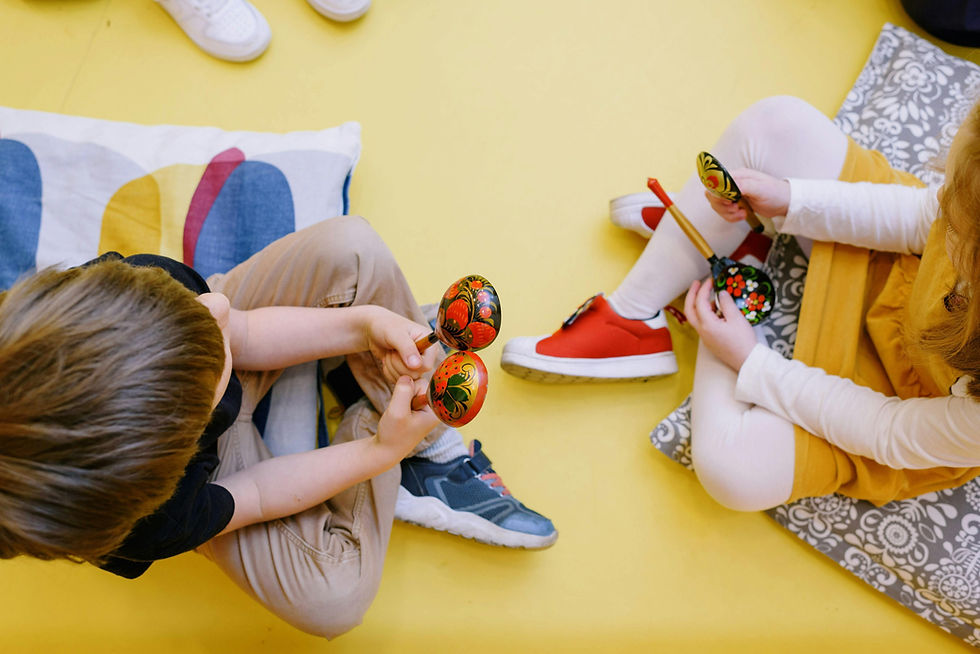What Type of Learner is Your Child and How Music Can Help
- Brittany Bennett
- Oct 15
- 4 min read

Unlocking Potential Through Personalized Music Education at NoteWise
Every child learns differently. Some respond best to sound, others to movement, and still others to visuals and patterns. Understanding your child’s learning style can make all the difference—not just in school, but in how they develop confidence, discipline, and creativity. At NoteWise Music Academy, we don’t believe in one-size-fits-all learning. We tailor our lessons to fit how your child learns best—whether they’re an auditory, kinesthetic, or visual learner.
Let’s explore the three main types of learning styles and how music can empower each one.
1. Auditory Learners: The Listeners and Hearers
How they learn best:
Auditory learners absorb information through sound. They remember what they hear and often think in rhythms, tones, and spoken words. You’ll often find them humming, singing, or repeating things out loud to remember them.
Signs your child is an auditory learner:
They love music and easily remember lyrics
They follow spoken directions well
They’re drawn to rhyming stories or audiobooks
They talk through problems to solve them
How music supports auditory learners:
For auditory learners, music lessons feel natural and intuitive. They excel in ear training, pitch recognition, and melody memorization. At NoteWise, we emphasize:
Call-and-response techniques: Students repeat rhythms or melodies after hearing them.
Aural skills training: Identifying intervals, notes, and chord progressions by ear.
Musical storytelling: Using sound to express mood, emotion, or narrative.
Our instructors guide auditory learners to listen critically and replicate what they hear, strengthening both musical memory and emotional expression.
Bonus Benefit: These learners often improve their language skills, pronunciation, and storytelling through music education.
2. Kinesthetic Learners: The Movers and Feelers
How they learn best:
Kinesthetic learners process information through physical activity and movement. They learn by doing, touching, and engaging their bodies in the learning experience.
Signs your child is a kinesthetic learner:
They’re always in motion—fidgeting, tapping, dancing
They learn through hands-on exploration
They excel in sports or physical activities
They get bored with long lectures or reading
How music supports kinesthetic learners:
Kinesthetic learners thrive when music is physical. Whether they’re tapping out rhythms or moving to a beat, music gives them an outlet for energy while building coordination and focus. At NoteWise, we incorporate:
Rhythm games and body percussion: Using claps, stomps, or instruments like drums and shakers
Movement-based activities: Dancing, conducting, or mimicking the shape of melodies
Instrument exploration: Giving them freedom to touch, try, and physically engage with instruments
By encouraging movement, our lessons help kinesthetic learners develop muscle memory, motor control, and confidence—all while making music fun and interactive.
Bonus Benefit: Music helps these learners improve attention span and fine motor skills, which translates to improved performance in other subjects like handwriting and sports.
3. Visual Learners: The Watchers and Seers
How they learn best:
Visual learners absorb information through sight. They respond to color, diagrams, and spatial awareness. These learners often visualize concepts in their minds and are great at observing patterns and visual cues.
Signs your child is a visual learner:
They love drawing, reading, or organizing things
They notice details and patterns quickly
They remember what they see better than what they hear
They prefer written instructions or visual demonstrations
How music supports visual learners:
Visual learners connect with music through notation, structure, and visual memory. At NoteWise, we design music lessons that engage their eyes and minds:
Sheet music reading: Teaching them to follow notes, symbols, and time signatures visually
Color-coded materials: Using visuals to identify scales, chords, or song sections
Graphic composition tools: Letting them create music with drag-and-drop software or visual cues
Visual learners thrive when they can "see" the music unfold. Our instructors use tools like visual schedules, charts, and diagrams to make learning feel organized and predictable.
Bonus Benefit: Music reinforces pattern recognition and reading comprehension, which can lead to stronger academic skills and creative confidence.
Why It Matters: Matching Method to Mindset
When music education aligns with your child’s learning style, something magical happens: they feel seen, supported, and motivated to grow. Instead of feeling frustrated or left behind, they start to flourish.
At NoteWise, we don’t just teach notes and rhythms—we teach kids. We take time to understand how they absorb, respond to, and interact with music. This personalized approach builds not only skills, but also:
Confidence: Kids feel capable and proud of their progress
Creativity: They learn to express themselves in a way that feels natural
Discipline: Music becomes a joyful habit, not a chore
By meeting kids where they are, we help them go further than they imagined.
Real Stories from the Studio
We’ve seen auditory learners compose original songs by ear. We’ve watched kinesthetic learners build focus and rhythm through drumming. We’ve celebrated visual learners mastering sheet music and performing with poise.
Here’s what one parent shared:
“We always thought my daughter was just ‘wiggly’ and distracted, but at NoteWise, her teacher channeled that energy into movement-based piano games. She’s learning faster and she’s happier, too.”
That’s what it’s all about: helping kids learn in a way that works for them.
Ready to Discover Your Child’s Musical Learning Style?
Not sure what type of learner your child is? Don’t worry—we’ll help you figure it out. Every first lesson at NoteWise includes a simple, stress-free learning style observation. We’ll guide your child through fun activities to see how they respond best.
Then we’ll personalize their music journey from there—because music should feel like it’s made just for them.
🎵 Book a lesson today and unlock the way your child learns best.





Comments